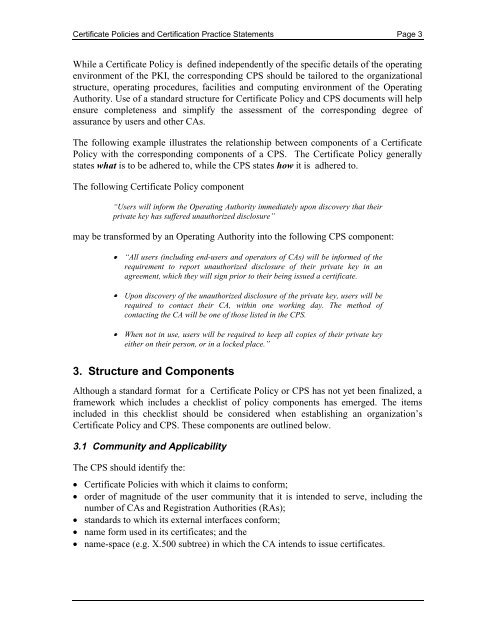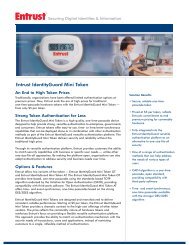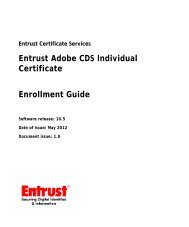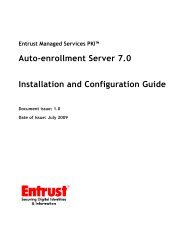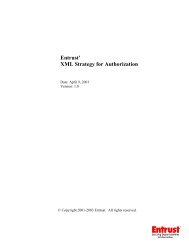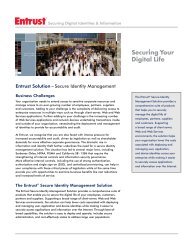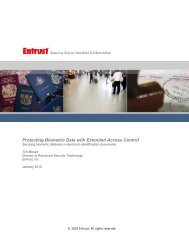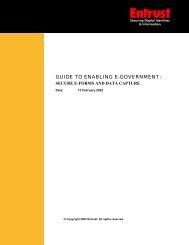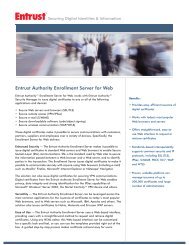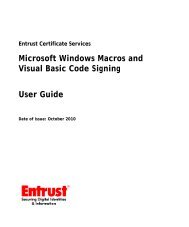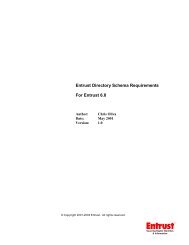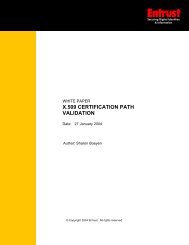Certificate Policies and Certification Practice Statements v.1.0 - Entrust
Certificate Policies and Certification Practice Statements v.1.0 - Entrust
Certificate Policies and Certification Practice Statements v.1.0 - Entrust
Create successful ePaper yourself
Turn your PDF publications into a flip-book with our unique Google optimized e-Paper software.
<strong>Certificate</strong> <strong>Policies</strong> <strong>and</strong> <strong>Certification</strong> <strong>Practice</strong> <strong>Statements</strong> Page 3<br />
While a <strong>Certificate</strong> Policy is defined independently of the specific details of the operating<br />
environment of the PKI, the corresponding CPS should be tailored to the organizational<br />
structure, operating procedures, facilities <strong>and</strong> computing environment of the Operating<br />
Authority. Use of a st<strong>and</strong>ard structure for <strong>Certificate</strong> Policy <strong>and</strong> CPS documents will help<br />
ensure completeness <strong>and</strong> simplify the assessment of the corresponding degree of<br />
assurance by users <strong>and</strong> other CAs.<br />
The following example illustrates the relationship between components of a <strong>Certificate</strong><br />
Policy with the corresponding components of a CPS. The <strong>Certificate</strong> Policy generally<br />
states what is to be adhered to, while the CPS states how it is adhered to.<br />
The following <strong>Certificate</strong> Policy component<br />
“Users will inform the Operating Authority immediately upon discovery that their<br />
private key has suffered unauthorized disclosure”<br />
may be transformed by an Operating Authority into the following CPS component:<br />
· “All users (including end-users <strong>and</strong> operators of CAs) will be informed of the<br />
requirement to report unauthorized disclosure of their private key in an<br />
agreement, which they will sign prior to their being issued a certificate.<br />
· Upon discovery of the unauthorized disclosure of the private key, users will be<br />
required to contact their CA, within one working day. The method of<br />
contacting the CA will be one of those listed in the CPS.<br />
· When not in use, users will be required to keep all copies of their private key<br />
either on their person, or in a locked place.”<br />
3. Structure <strong>and</strong> Components<br />
Although a st<strong>and</strong>ard format for a <strong>Certificate</strong> Policy or CPS has not yet been finalized, a<br />
framework which includes a checklist of policy components has emerged. The items<br />
included in this checklist should be considered when establishing an organization’s<br />
<strong>Certificate</strong> Policy <strong>and</strong> CPS. These components are outlined below.<br />
3.1 Community <strong>and</strong> Applicability<br />
The CPS should identify the:<br />
· <strong>Certificate</strong> <strong>Policies</strong> with which it claims to conform;<br />
· order of magnitude of the user community that it is intended to serve, including the<br />
number of CAs <strong>and</strong> Registration Authorities (RAs);<br />
· st<strong>and</strong>ards to which its external interfaces conform;<br />
· name form used in its certificates; <strong>and</strong> the<br />
· name-space (e.g. X.500 subtree) in which the CA intends to issue certificates.


